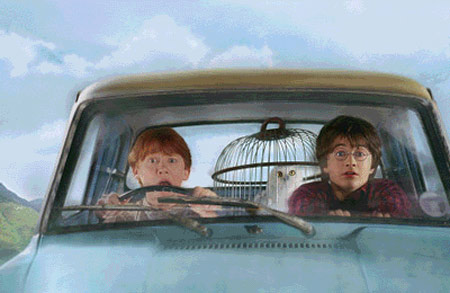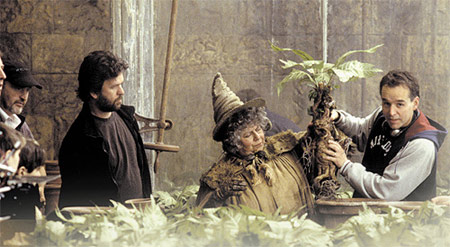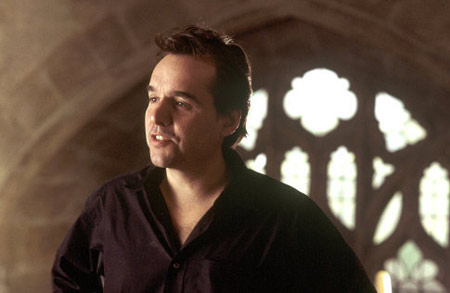By Ted Elrick
Harry Potter is one of the most successful and widely read series of books in recent memory. Taking those tales, loved by millions of adults and children worldwide, from printed word to motion picture screen was a formidable undertaking for director Chris Columbus.
He first came to Hollywood's attention when Steven Spielberg's production company, Amblin, purchased Columbus' original screenplay for Gremlins.
"I consider my years at Amblin to be my graduate course in film," said Columbus, who at the time was fresh from New York University's prestigious film school. "With Amblin on Gremlins, they wanted me to be constantly rewriting it. It was great for me because I was learning."
Director Chris Columbus with actors Rupert Grint (left) and Daniel Radcliffe
Columbus recalled that in the early '80s Amblin was a small, homey place. "They set up an office for me right down the hall from Spielberg," he said. "Steven told me when I was writing Gremlins (directed by Joe Dante), The Goonies (directed by Richard Donner) and Young Sherlock Holmes (directed by Barry Levinson), that when I finished a scene, I should just come into his office, show it to him and we'd talk about it. Basically, I could go into his office whenever I wanted. He'd make some changes and I'd run down the hall and continue writing.
"It was an amazing experience. He was incredibly generous with his time, patience and knowledge. He was always there for me during two and half, three solid years of a really wonderful collaboration."
The experience also confirmed what he'd known all along. That, first and foremost, when making a motion picture he needed to consider that he was making something for an audience.
Columbus' directorial debut came with 1987's Adventures in Babysitting followed by Heartbreak Hotel, a film he also wrote. But it was the monster hit Home Alone, from a John Hughes script, that really propelled his directing career to the next level. Budgeted at $15 million, Home Alone reaped $533 million at the worldwide box office. With Home Alone 2: Lost in New York (1992) and Mrs. Doubtfire (1993), Columbus joined a small group of directors whose work earned more than $1 billion worldwide. If there is a common theme to his films, it would be variations on familial relationships. Home Alone is about a boy who loses his family and must find the inner strength to survive alone. Mrs. Doubtfire is about a man who loses his family through divorce and the only way he can reenter their world is by doing the outrageous, dressing up as the family housekeeper. Only the Lonely, which Columbus also wrote, is about a man who needs to extricate himself from his mother's domineering presence in order to marry the woman he loves. And, of course, there's Harry Potter, the tale of a boy living a miserable existence with his aunt and uncle who finds refuge with an extended loving "family" at Hogwarts, a school for wizards.

Rupert Grint (left) and Daniel Radcliffe
"It's always about the search for a family or the redefining of who your family is," Columbus said. "I guess it's the fact that sometimes you play on your biggest fear. My biggest fear in my life would be to lose my family. So I've always been drawn to that theme. I mean, it's odd. I never really talked or thought about it much, but if you look at the films I've done, particularly the films I'm really most happy with, and even the films that weren't that successful, I think there is a thematic link. Most of them are about someone potentially losing their family."
Harry Potter was a project that many in Hollywood wanted to tackle. Columbus won the plum assignment after meeting with the books' author, J.K. Rowling, in Scotland. "I really knew nothing about what she wanted to do with the books or the movie," he said.
When I sat down with Jo, we immediately clicked. She has a great sense of humor. She's obviously a very bright, perceptive person. And I just explained to her what I wanted to do. I told her what my vision was for the movie, how I saw it, how I wanted to cast it. I could have gone in with the traditional Hollywood thing, saying I wanted to cast popular American actors to play the roles, things like that. But my desire was to remain faithful to the story, the characters and the integrity of those characters. After about 45 minutes she said, 'Yea, that's exactly the same type of movie I want to make.' It was a great meeting because I realized that I had found a solid collaborator. And it was important because she knows this world better than anyone else."
Contrary to popular belief that J.K. Rowling dominated every decision about the production, Columbus says he was given free reign to visualize the world of Harry Potter. For instance, as described in the books, the students at Hogwarts wear wizard's robes over normal street clothes such as jeans and sneakers. Columbus felt that looked too much like a Halloween costume and decided to have the students wear a school uniform under their robes.
He also feels that with the caliber of the crew working on both pictures, no one should expect that they waited to be given marching orders over every detail. "We certainly included Jo Rowling in on all of our plans about the kind of movie we wanted to make, the look of it, the feel of it," he said, "but at the same time she never once said, 'Oh no. This is absolutely wrong.' She was incredibly valuable as a collaborator. She could tell you the color of wallpaper in the Gryffindor common room if you asked. But there were numerous things we needed to change because of the way I wanted to do the films. The reason I feel good about them, more than their commercial success, is that I feel that I got everything that I wanted to get on screen from my point of view."
Steve Kloves (director/writer of The Fabulous Baker Boys and writer for Curtis Hanson's The Wonder Boys) was chosen to adapt the Harry Potter books. Because of his own screenwriting background, Columbus feels he has always had good relationships with other writers, yet his collaboration with Kloves, from script development through production, was something of a dream situation. Both are "rabid fanatics" of the books. Like Star Trek's Trekkies, Columbus feels he and Kloves could be called "Potterheads."

Columbus on set of Harry Potter and the Chamber of Secrets
"A conversation between Steve and me can get a little, to be honest with you, insane," he said. "We're really obsessive about it. If people overheard us they might think, 'These guys are nuts the way they talk about Muggles (non-magical people) and Quidditch (the fast-paced sport of wizards).' So Steve was incredibly involved. He wasn't on the set because he prefers to be at home with his family as opposed to being in England. I was able to offer him suggestions or even rough versions of scenes I had in my head. I'd just type them out quickly, show them to him, he'd fix what was wrong with them and add what he thought would enhance them and we'd be bouncing pages back and forth forever. Steve's the kind of writer who faxes you pages every couple of days. You can call, make corrections and the next day you'll get six versions of each scene. He will give you choices — and not many writers will do that."
Still, there were times on the set when Columbus would also need to write some new lines or restructure a scene. For him, that on-set writing falls more into the category of improvisation; and surprisingly, with a film laden with special effects, there was a good deal of room for improvisation.
Examples of on-the-set improv include when Draco Malfoy (Potter's student nemesis played by actor Tom Felton) sees Potter in the guise of his own henchman Goyle and says, "I didn't know you could read?" Or when actor Jason Isaacs, playing Draco's father Lucius, improvised the line, "Let us always hope that Mr. Potter is around to save the day." Columbus then told actor Daniel Radcliffe (Harry Potter) to reply, "Don't worry I will be," but to say it like Clint Eastwood. The line reading turned out to be nothing like Eastwood, and instead came from the determination of the character, melding perfectly with the rest of the film.
This luxury to improvise came as a surprise to Columbus who had gone into production for Sorcerer's Stone feeling he'd be stuck with laboriously working out shots for huge motion control cameras and being married to his storyboards. To his amazement, he found that with advances in the technology, by adding a few LCD lights into the frame he could add a CGI character into any situation.

Director Chris Columbus
"Suddenly I felt I could adjust the frame from what we'd storyboarded," he explained. "You can basically mimic anything. It was fascinating because all these scenes could come to life. It didn't occur to me before I started shooting Chamber that I could actually shoot a great deal of the Basilisk (a giant serpent) sequence at the end of the film on a Steadicam. That kept the entire sequence moving and alive, kept it from the point of view of the snake. So effects these days are an amazingly liberating tool for a director."
Which is one of the reasons why Chamber of Secrets is more visual than the first film, Harry Potter and the Sorcerer's Stone. Another reason is that Columbus has seen all the films as being linked. The first needed more time to set up what would be paid off in future films. Add to that a cast of children — Radcliffe, Rupert Grint (Ron Weasley), and Emma Watson (Hermione Granger) — becoming more comfortable in their roles and in the motion picture process, and Chamber of Secrets gave Columbus and the cast the opportunity to "play with it a little more this time around."
Columbus rehearsed very little with the children since many had little acting experience and he didn't want to lose their spontaneity. Instead, he drew upon past experiences from Home Alone and Mrs. Doubtfire, and met with the young actors in an office, reading through the lines with them to make sure the dialogue and situations worked and also to get them comfortable with their characters.
During production, because the children were only available a limited number of hours each day, Columbus would initially walk through the scenes, playing Potter and enlisting any others who happened to be around standing in for the other characters, so that he could work out the shots with the cameraman.
"When the kids finally walked through the scene," he explained, "there was a really fresh attitude from them because it was the first time they had seen or done it. On this film, what used to take us eight or nine takes on the first, now took us three or four. We were able to move more quickly and there was a certain sense of spontaneity and energy with each scene because the kids came to it fresh each day."
The limited workday for the child actors also enabled Columbus to work with his editor, Peter Honess and get well ahead of schedule. "On Chamber of Secrets we edited the film every day when the kids were in school," he explained. "You figure you send the kids to school three hours a day. That's three hours of editing time, four if you skip lunch. In this day of computerized editing, where it's just a click of the mouse and you've changed a scene, it's extremely helpful to spend that much time in the editing room while you're shooting. You see what you need. By the time you get to the last couple of months of shooting, you actually save some shooting days because you see that you may not need to shoot certain scenes. It was a wonderful process because when I finished my first cut of the film, we were way ahead. It wasn't a rough assembly, it was a fine cut."
What could he point to and say that the two Harry Potter films are his vision?
"Let's face it. It's basically the look and design of both pictures," he said. "I love the books and I'm an obsessive fan of the books. But when I look back at them, I can't say, 'Yes, that's exactly the way the Great Hall was written.' Or 'That was the way the Chamber of Secrets was meant to look.' I think we used the book as a starting point. I think it was extremely helpful to have Stuart Craig as my production designer. He's a genius. Being able to work so closely with Stuart and our team of conceptual artists, I basically got to make the films I wanted to make. So when you talk about personal vision, I was able to create these worlds that didn't exist in a tangible way. They existed on paper, but we were given complete freedom in the way we designed the picture.
"Believe me, the pictures could have gone a lot of ways. You could have designed the films to be much more stylized and much more over the top. I thought that Hogwarts had to feel like a place that existed in reality. When I think about it and what I ended up with on film, I think if you loved the way it looked, you can thank me. If you hated the way it looked, you can blame me because it is what I intended to do."
"I find that you tend to work well with people who truly are collaborative. There are a whole variety of problems that can arise in this relationship. There are directors who think they can write, who can't write and then interfere with the screenwriter's process. There are writers who refuse to change any of their written words because they don't have an understanding of how a film is made. The perfect scenario is a director who understands the writer's process, and a writer who understands the filmmaking process.
"Get those two people together, and you'll have a wonderful collaboration. There's give and take. Making a film is not like the theater. It's not like every word is etched in stone. Things change when you get out on the set, and a writer has to be prepared to accept those changes."